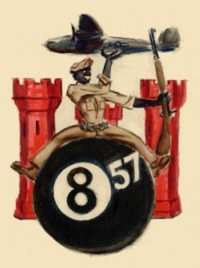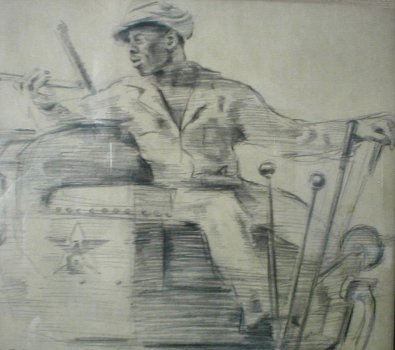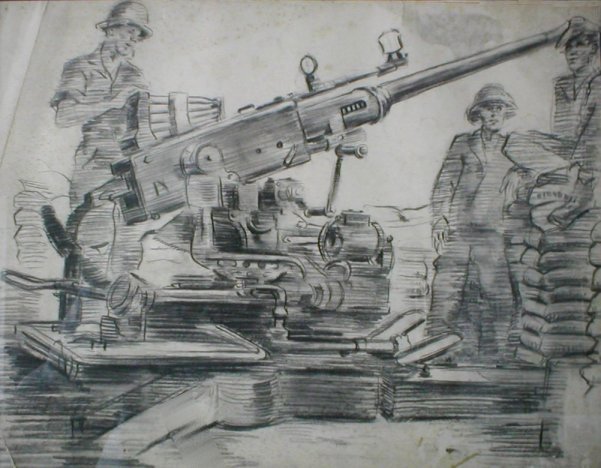

“The Aviation Engineer Battalion, was an unheralded unit designation, but one so essential to the war in the Pacific area. My first experience with them was the 808th Engineers which built all the airdromes around Port Moresby, New Guinea. They had all the machinery and all the saw mills, and if one wanted to enhance his tent for better living conditions, he had better grab a 6x truck and head for the sawmill in the boondocks and have something to trade with the sergeant in charge. But mainly, after the island to island campaigns got going every landing featured the engineers in the first wave. I don't know where we got all those people, but they just kept on coming. My impression was that when the first sergeant hollered, they all jumped and got things done. They first worked on runways that were narrow and about 5000' long. These would accommodate P-39s which I first flew in New Guinea. Later on we got P-47s and flew from wider, steel planked dromes which accommodated the bigger bombers in the jungle area.”

|
| An Engineer Operates a D-8 Dozer on an Airfield |
Slowly United States and Australian military forces pushed their way from their toehold at Port Moresby.
Less than a month after the critical Battle for Leyte Gulf (October 23-25 1944) the 857th reached the town of San Pablo on the Island of Leyte in the Philippines.
- Guy Rittmann -
| 857th Engineer Aviation Battalion Tour of Duty | ||||
|---|---|---|---|---|
| The 857th E.A.B. was credited with participation in the New Guinea, Leyte and Luzon campaigns | ||||
| Dates | Site | Battalion Notes | ||
| Nov | 15th | 1942 | Elgin Field, Florida |
857th E.A.B is formed. Commanding Officer Major William Hotchkiss. Executive Officer Captain Frank Ritchie. Operations and Training Officer Lt. Everette Frazier (retired Lt. Col Frazier). |
| Feb | 26th | 1943 | San Francisco, California | Soon after arriving at Camp Stoneman, the 857th ships out on USS Republic(AP-33), a refitted luxury liner(formerly called the USS President Grant). |
| Mar | 23rd | 1943 | Brisbane, Australia | 857th arrived in Australia for brief stop over. |
| Apr | 8th | 1943 | Port Moresby, Papua New Guinea |
857th arrived in New Guinea and replaced the 808th E.A.B who went for R&R in Sydney Australia. Maintained the Jackson airdrome (7 Mile Drome) including constructing revetments, taxiways, roads and built half of a 5000 foot black-top runway. Made the airdrome at Kila Kila (3 Mile Drome) operational by correcting severe drainage problems and adding a runway approach. Built surfaced road from Kila Kila airdrome to a fueling station and bivouac area. Reduced grade change in another road at opposite end of drome. Built standpipes for aviation fuel at both Jackson and Kila Kila dromes. Built heavy bomber revetments and hardstandings at Wards Airdrome (5 Mile Drome). Built 16 hardstandings at Berry Drome (12 Mile drome). Laid concrete foundations for 2 radio towers on Daugo Island. |
| Sep Sep | 15th 29th | 1943 1943 |
Oro Bay, Papua New Guinea | Company "A" assembled pontoon barges used later as floating docks at Lae and Finschafen. |
| Sep Dec | 30th 12th | 1943 1943 |
Lae, N.E. New Guinea |
Along with 836th E.A.B. the 857th repaired priority roads and bridges to Nadzab. Facilitated the unloading of 100 octane gas from LCVs. Prepared beaches for landings. |
| Dec Jan | 12th 23rd | 1943 1944 |
Nadzab, N.E. New Guinea |
857th prepared airfield, including 2 runways at strip #2, taxiways and hardstandings. Built headquarters, housing and storage facilities. Built and maintained roads. Cleared area of brush and kunai grass. Installation and operation of water points |
| Feb Jul | 3rd 16th | 1944 1944 |
Finschhafen, N.E. New Guinea |
857th built a huge Base Ordnance Depot. Built hutments with concrete floors. Built coral roads including one leading from Dreger Harbor. Built a base garbage dump. |
| Jul Nov | 28th 10th | 1944 1944 |
Noemfoor, Netherlands New Guinea |
857th worked on and finished the Kornasoren airdrome which had been partial constructed by the Japanese. Noemfoor becomes an important staging area for the USAAF preparing to retake the Philippines. Company "B" constructed and operated water point no. 5. Bob Hope and the USO entertain the troops. |
| Nov | 19th | 1944 | San Pablo, Leyte, Philippines | 857th arrived in Philippines. |
| Nov Mar | 24th 20th | 1944 1945 |
San Joaquin, Leyte, Philippines |
857th constructed the northern half of air strip at Tanauan Air Field, while the 1897th E.A.B. worked on southern half. Established a rock quarry. Then went on to repair several roads by leveling, widening, and improving drainage. Constructed a public water point in southern San Joaquin. Constructed four, 5000 sq ft each hardstandings for an ordnance ammunition dump, and three more 5000 sq ft hardstandings at a storage area for aviation gasoline. Laid some 6 miles of aviation gasoline pipe lines. Repaired and enhanced operations building at the 27th radio receiver site. Constructed 15 huge ward floors for the 133rd General Hospital. |
| Mar Apr | 25th 26th | 1945 1945 |
Angeles, Luzon, Philippines |
While serving at Clark Field the 857th constructed the east runway. Reconstructed and maintained a 7 mile stretch of road from Angeles to Porac |
| Apr Aug | 26th 15th | 1945 1945 |
Manila, Luzon, Philippines |
857th served at Nielson Field. Built comfortable living quarters for General Headquarters(GHQ) personnel, including lighting systems, water and sewer pipelines, showers, latrines, wash basins and side walks. Cleared area between Nichols Field and Fort Mckinley for construction of some 20 type "C" hutments. On August 15th 1945 the 857th E.A.B. was inactivated. |

|
| Preparing an Anti-AirCraft Gun |
| Credits for Web Pages on the 857th E.A.B. | ||
|---|---|---|
|
I have received a couple of emails from sons of 857th veterans.
I have greatly appreciated the correspondence with fighter pilots Carlos Danacher and Rip Collins of the 35th Fighter Group, 40th Fighter Squadron.
The information on Lt. Col Frazier was from the research of art gallery owner Mike Breslin.
- Guy Rittmann - |
Return to main WWII page |
 Site Developer (Guy Rittmann)
Site Developer (Guy Rittmann)